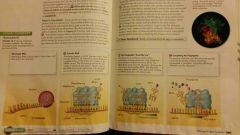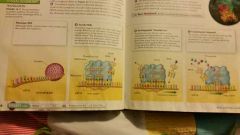![]()
![]()
![]()
Use LEFT and RIGHT arrow keys to navigate between flashcards;
Use UP and DOWN arrow keys to flip the card;
H to show hint;
A reads text to speech;
39 Cards in this Set
- Front
- Back
- 3rd side (hint)
|
The three types of RNA
|
Messenger, Ribosomal, Transfer
|
|
|
|
Differences between RNA and DNA
|
1) RNA- ribose
DNA- deoxyribose 2) RNA is single stranded DNA is double stranded 3) RNA has uracil instead of thymine |
|
|
|
Messenger RNA (mRNA)
|
Type of RNA that carries copies of instructions for assembling amino acids into proteins from DNA to the rest of the cell
|
|
|
|
Ribosomal RNA (rRNA)
|
Type of RNA that combines with proteins to form ribosomes
|
|
|
|
Transfer RNA (tRNA)
|
Type of RNA that carries each amino acid to a ribosome during protein synthesis
|
|
|
|
How does the cell make RNA?
|
Segments of DNA serve as templates to produce complementary RNA molecules
|
|
|
|
Transcription
|
Segments serve as templates to produce complementary RNA molecules
|
|
|
|
RNA Polymerase
|
Binds to DNA during transcription and separates the DNA strands
|
|
|
|
Promoters
|
Signals in DNA molecules that show RNA polymerase where to begin to make RNA
|
|
|
|
Introns
|
Sequence of DNA that is not involved in coding for a protein
|
|
|
|
Exons
|
Expressed sequence of DNA; codes for a protein
|
|
|
|
Transcription vs. Translation
|

Transcription
~Segments of DNA serve as templates to produce complementary RNA molecules ~RNA polymerase Translation ~Decoding of an mRNA message into a protein ~Anticodon |
|
|
|
Polypeptide
|
Long chain of amino acids that makes proteins
|
|
|
|
Genetic Code
|
Collection of coding of mRNA, each of which directs the incorporation of a particular amino acid into a protein during protein synthesis
|
|
|
|
Codon
|
Group of three nucleotide bases in mRNA that specify a particular amino acid to be incorporated into a protein
|
|
|
|
What is the genetic code, and how is it read?
|
Read 3 "letters" at a time, so each word is 3 bases long and corresponds to a single amino acid
|
|
|
|
Start codon
|
Methionine or AUG
|
|
|
|
What role does the ribosome play in assembling proteins?
|
Ribosomes use the sequence of codons in mRNA to assemble amino acids into polypeptide chains
|
|
|
|
Translation
|
Decoding of an mRNA message into a protein
|
|
|
|
Steps in Translation
|
The ribosome binds to mRNA at a specific area.
The ribosome starts matching tRNA anticodon sequences to the mRNA codon sequence. Each time a new tRNA comes into the ribosome, the amino acid that it was carrying gets added to the elongating polypeptide chain. The ribosome continues until it hits a stop sequence, then it releases the polypeptide and the mRNA. The polypeptide forms into its native shape and starts acting as a functional protein in the cell. |

|
|
|
Anticodon
|
Group of three bases on a tRNA molecule that are complementary to the three bases of a codon of mRNA
|
|
|
|
Role of tRNA in Translation
|
Deliver amino acid called for by each codon on the mRNA
|
|
|
|
Role of mRNA in Translation
|
Carry coded message that directs process
|
|
|
|
Role of rRNA in Translation
|
Help hold ribosomal proteins in place and help locate beginning of mRNA message
|
|
|
|
What is the "central dogma" of molecular biology?
|
Information is transferred from DNA to RNA to protein
|
|
|
|
Gene expression
|
Process by which a gene produces its product and the the product carries out its function
|
|
|
|
Mutations
|
Heritable changes in genetic information
|
|
|
|
Two types of mutations
|
Gene and chromosomal
|
|
|
|
Point mutations
|
Gene mutation in which a single base pair in DNA has been changed
|
|
|
|
Types of Gene Mutations
|
Substitution, Insertions, Deletions
|
|
|
|
Substitutions
|
One base is changed to a different base
Usually affect no more than a single amino acid and sometimes have no effect at all |
|
|
|
Insertions and Deletions
|
Point mutations when one base is either added or removed
Effects of these mutations can be drastic Frameshift mutations |
|
|
|
Frameshift Mutations
|
Mutation that shifts the "reading frame" of the genetic message by inserting or deleting a nucleotide
|
|
|
|
Chromosomal Mutations
|
Changes in the number or structure of chromosomes
Deletion - loss of all or part of a chromosome Duplication - produces extra copy of all or part of chromosome Inversion - reverses direction of parts of chromosome Translocation - when part of one chromosome breaks off and attaches to another |
|
|
|
How do mutations affect genes?
|
Some have little or no effect
Some produce beneficial variations Some negatively disrupt gene function |
|
|
|
Mutagens
|
Chemical or physical agents in the environment
|
|
|
|
Harmful Effects of Mutations
|
Can dramatically change protein structure or gene activity
|
|
|
|
Beneficial Effects of Mutations
|
Mutations often produce proteins with new or altered functions that can be useful to organisms in different or changing environments
|
|
|
|
Polyploidy
|
When an organism has an extra set of chromosomes
|
|

